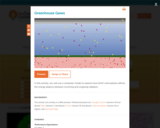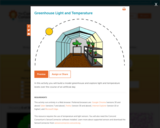
Students study past climate change, explore the effect of greenhouse gases on Earth's atmosphere today, and consider human impact on global warming.
- Subject:
- Science
- Material Type:
- Lesson Plan
- Provider:
- PBS LearningMedia
- Date Added:
- 11/06/2023

Students study past climate change, explore the effect of greenhouse gases on Earth's atmosphere today, and consider human impact on global warming.

This video segment adapted from NOVA/FRONTLINE demonstrates the physical property of carbon dioxide that causes the greenhouse effect. Includes background reading and discussion questions. [2:26]

This video segment adapted from NOVA/FRONTLINE examines the greenhouse effect, its role in keeping Earth habitable, and the industrial changes that have led to an increase in the planet's average temperature. Includes background reading and discussion questions. [2:15]

This lesson introduces students to the concepts of air pollution and technologies that have been developed by engineers to reduce air pollution. Students develop an understanding of visible air pollutants with an incomplete combustion demonstration, a "smog in a jar" demonstration, construction of simple particulate matter collectors and by exploring engineering roles related to air pollution. Next, students develop awareness and understanding of the daily air quality and trends in air quality using the Air Quality Index (AQI) listed in the newspaper. Finally, students build and observe a variety of simple models in order to develop an understanding of how engineers use these technologies to clean up and prevent air pollution.

Explore how the Earth's atmosphere affects the energy balance between incoming and outgoing radiation. Using an interactive model, adjust realistic parameters such as how many clouds are present or how much carbon dioxide is in the air, and watch how these factors affect the global temperature.

Make your own miniature greenhouse and measure the light levels at different "times of day"--modeled by changing the angle of a lamp on the greenhouse--using a light sensor. Next, investigate the temperature in your greenhouse with and without a cover. Learn how a greenhouse works and how you can regulate the temperature in your model greenhouse.

Student teams model the Earth's greenhouse effect using modeling clay, ice chunks, water, aluminum pie tins and plastic wrap. They observe and record what happens in this closed environment and discuss the implications of global warming theory for engineers, themselves and the Earth.

This resource provides information on all of the aspects of global warming, climate change, and the future of the earth.

A detailed overview of the greenhouse effect, with explanations about Earth's atmosphere gases referred to as greenhouse gases, and the factors that influence the heat-trapping ability of a greenhouse. All information is reinforced through pictures, graphs, and learning activities. Learning activities give background, procedure, and assessment ideas.

"Earth's Energy Budget and the Greenhouse Effect" is a lab activity in which students use computers and scientific applications software to access, display, describe, analyze, and interpret global, climate-related data sets related to the earth's energy budget and the greenhouse effect.

Concepts underlying the first of the Essential Principles of the Climate Sciences are aligned with topics typically taught in the elementary grades. This article identifies lessons that will help elementary students develop an understanding of how Sun's light warms Earth and how variations in daylight hours are associated with seasonal change. This article appears in the free, online magazine Beyond Weather and the Water Cycle.

Students observe demonstrations, and build and evaluate simple models to understand the greenhouse effect, the role of increased greenhouse gas concentration in global warming, and the implications of global warming theory for engineers, themselves and the Earth. In an associated literacy activity, students learn how a bill becomes law and research global warming legislation.

With two simple classroom experiments and easy-to-read text, this original story is designed to introduce young learners to the greenhouse effect. The author provides different versions of the story for grades K-2 and 3-5, as well as different formats for differentiated instruction. The free online magazine Beyond Weather and the Water Cycle focuses on principles of climate literacy that are appropriate for young learners.

Students explore Mercury and Venus, the first and second planets nearest the Sun. They learn about the planets' characteristics, including their differences from Earth. Students also learn how engineers are involved in the study of planets by designing equipment and spacecraft to go where it is too dangerous for humans.

Students learn about the advantages and disadvantages of the greenhouse effect. They construct their own miniature greenhouses and explore how their designs take advantage of heat transfer processes to create controlled environments. They record and graph measurements, comparing the greenhouse indoor and outdoor temperatures over time. Students are also introduced to global issues such as greenhouse gas emissions and their relationship to global warming.

Information and activities looking at the impact of industrial and agricultural practices on global warming.

Younger students will love this colorful yet educational site on global warming and climate change. Easy to read factual information is included. Available in many different languages.

Thawing permafrost can have devastating effects for a region. It can lead to the ground becoming unstable, landslides, and sinking. This video shows some effects of thawing permafrost in Fairbanks, Alaska, and provides a glimpse of what permafrost looks like underground. Included are teaching tips and background information. Closed caption available. [2:18]

How do greenhouse gases affect the climate? Explore the atmosphere during the ice age and today.

What is the role of Carbon Dioxide in the atmosphere? What is the Greenhouse Effect? Why does the Earth have too many blankets, making it hot and clammy? Those questions are answered in this Nutshell. [2:45]